Brahman.co.za
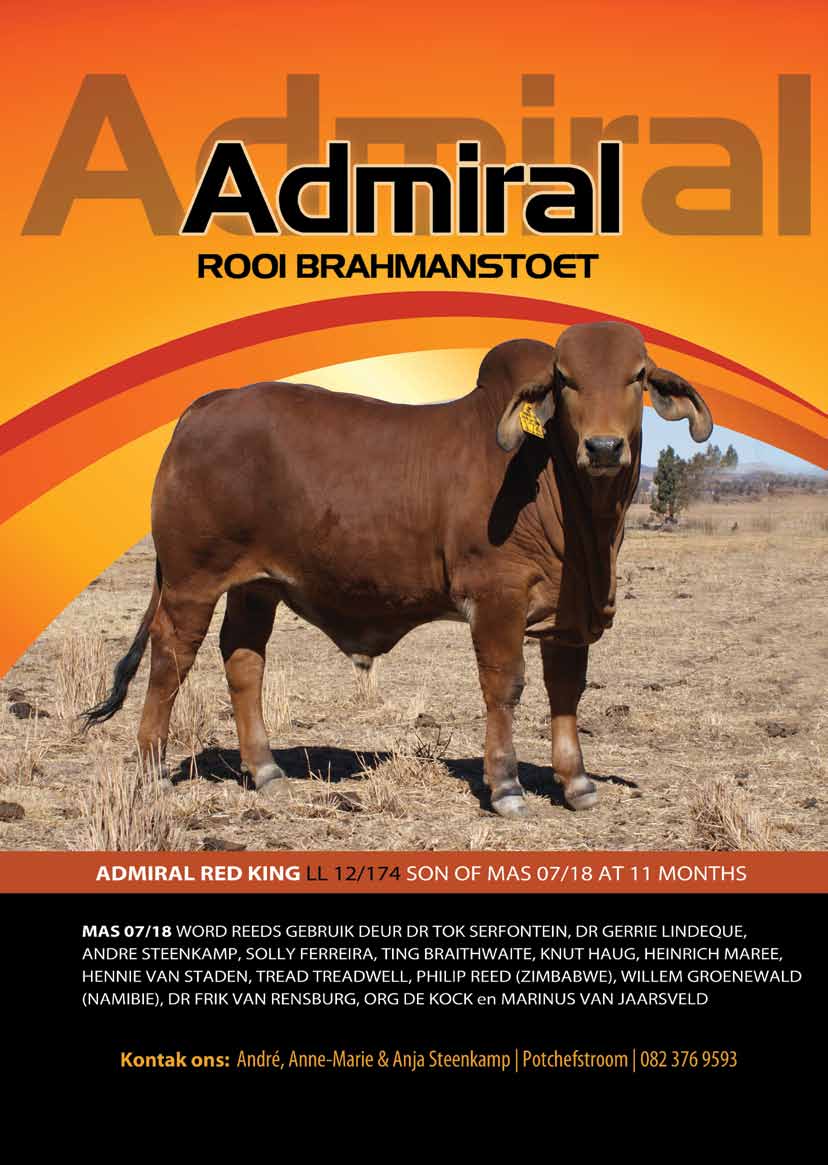
B R A H M A N JoeRNAAl • JouRNAl • oK T oBeR/oCT oBeR 2013
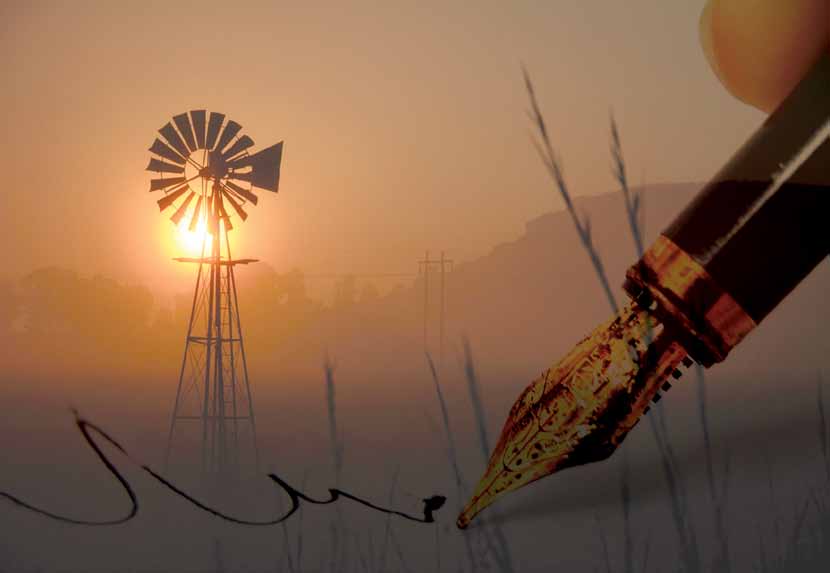
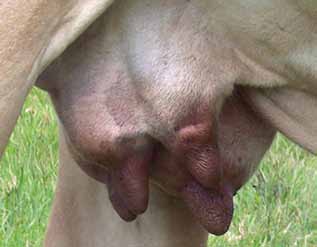
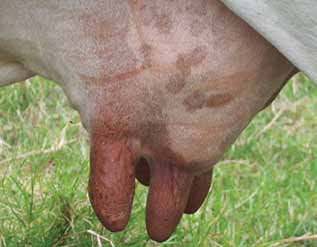
An udder with weak attachments and suspension.
A pendulous udder with poorly spaced teats that
The unevenness of quarters and teats will cause
are thick and prone to ballooning. These udders
calf sucking problems and mortalities. Poor shape
result in poor suckling and possibly increased calf
and texture leads to injury causing scar tissue and
reduced milk flow.
We would like to thank Alex Ashwood of the Australian Brahman Breeders' Association for permission to
reproduce this article.
Die Raad en Personeel
BloemfonteinBeste vriende,Ons het reeds bedank as Lid van die Genootskap maar nog nie ons
dank teenoor julle uitgespreek nie.
Dit is bloot as gevolg van die feit dat ek nie weet wat om te sê nie.
Hoe staak mens iets wat jy 20 jaar mee besig was en persone wat
al die tyd jou bygestaan het. Hierdie 20 jaar was van die mees
opwindenste van ons lewe.
Maar soos die Woord ons leer "Daar is ‘n tyd om klippe bymekaar te
maak en om klippe weg te gooi" Ons is nou daar - alles het ‘n tyd. Dit was vir ons n groot plesier en voorreg om met die Brahmanbees
betrokke te wees. Om hulle te kon teel, mee te werk en mee te
speel.
Ons wil dan nou ook die Genootskap (dit sluit julle almal in) van harte
bedank vir al die jare se belangstelling, ondersteuning, goeie raad,
vriendelikheid en diens. Ons is dankbaar en sal dit nooit vergeet nie.
Ons wens julle voorspoed toe en mag die Brahman Beestelers-
genootskap steeds van krag tot krag gaan.
Vriendelike groete
Koos & Bets Grobler
B R A H M A N JoeRNAAl • JouRNAl • oK T oBeR/oCT oBeR 2013


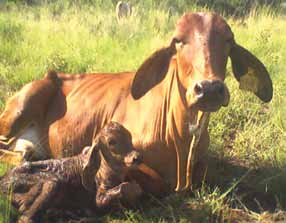
head, reverses, lies down or sticks it's tongue out the side
of it's mouth, resisting teat presence. These calves are NOT
Poor Sucking Reflex (PSR) syndrome, otherwise known
dummies! These calves are severely traumatized and in pain.
as Dummy Calf syndrome, has been debated for decades.
Their tongues may only be slightly swollen, hardly visible to
Theories ranged from genetics to nutrition, to climate,
a trained eye, but the result is that, not only is the tongue
neurological disorders, maternal rejection and abnormal
extremely painful to pressure, but it cannot fold to latch
milk production. However, even though mentioned, the role
around the teat, hence pushing the tongue out the side of it's
that dystocia plays in the syndrome, seems to have been
mouth. These calves also have extremely painful heads and
jaws. Suckling is impossible at this stage. The hungry calf will resort to nudging the neck skin or navel skin of the mother,
An abnormal, or dystocic birth, is caused by factors that
or even the udder, but cannot latch. Sometimes, the cortisol
disrupt, either the foetal system or maternal system, during
depletion is so severe that the calf cannot stand. Left unaided,
these calves will die.
The birth process, that the foetus initiates, involves a series
Tongue length also seems to play a role in PSR syndrome. The
of hormonal, or endocrine, events. Approximately nine days
longer the tongue, the weaker the sucking reflex. Brahman
before birth, the foetal adrenal gland secretes an increased
cattle generally have longer jaws than Bos Taurus cattle.
amount of cortisol (stress hormone). The foetal cortisol
Longer jaws equal longer tongues. Calves with broader heads
stimulates the placental function, and the birth process begins.
and shorter jaws suckle a lot easier than those with longer,
Maximum levels of cortisol are reached within 3 hours of
narrow heads, even if the broader headed calf is dystocic.
birth. Should the birth process be disrupted and prolonged, the newborn calf could present with ‘Dummy Calf Syndrome'.
Calves that are slow to stand and suck, should routinely be
Bull calves are affected more often than heifer calves, simply
given Predef immediately, to help restore the cortisol levels,
because they are larger at birth.
and a painkiller after 24 hours, in extreme cases. Finadyne, or Pyroflam given at the recommended safe dosage will reduce
The cortisol continues to be secreted until it becomes
pain and inflammation. Within 36 hours, 1ml of Multimin with
depleted, in a prolonged birthing process. This all important
Selenium. After treating the calf with Predef, wait for about 2
hormone is responsible for the vitality of the newborn calf.
hours, then gently try to give the calf one litre of colostrum,
It provides the energy for the calf to start to shiver, thereby
milked out of the mother. Avoid putting too much pressure
kickstarting it's own body temperature, or thermo-regulation.
on the head or jaw. Do NOT force the calf to drink. If
It also enables the newly born calf to stand and suckle.
necessary, a vetenarian may need to tube feed the calf. Once
Another contributing factor towards this ‘Dummy Calf ', is
the calf is sucking the bottle teat, try and let it drink on the
the physiological trauma that a dystocic birth causes. The
udder, with the mother in a crush. Colostrum is no longer as
continued, extreme pressure on the soft bones of the head,
effective after 24 hours after birth so it is important to get
eye and jaw area, results in ruptured blood vessels in the eye,
the dystocic calf treated for pain and swelling as soon after
brain and spine, and the lack of oxygen, or hypoxia, due to a
birth as possible.
compressed umbilical cord, causes the tongue and sometimes
In the ever increasing desire to produce fast growing calves,
the head, to start swelling. In severe cases, the liver may also
and text book performance statistics, larger foetuses are
rupture and the calf will die within 24 hours after birth.
also being created. There are other causes for Weak Calf
Sometimes, all the dystocic calf needs is a little assistance
Syndrome, but the major cause of Dummy Calf Syndrome
to enable it to suck, but most times, the calf drops it's
seems to be the cortisol depletion in a dystocic neonate.
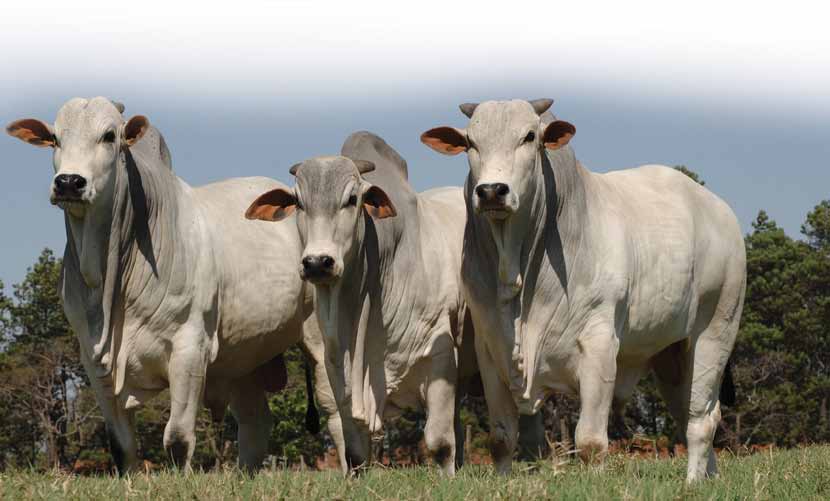
KI PROJEK • AI PROJECT
Hierdie projek vind plaas as gevolg van samewerking tussen die Genootskap, die bul se eienaar, en Taurus. Die Genootskap help met identifisering en bemarking van Brahman bulle wat by die KI stasie moet wees. Die eienaar verskaf die bul, en Taurus het die infra-struktuur om top kwaliteit, siektevrye semen te tap en binne en
buite Suid-Afrika te versprei.
Taurus is die enigste geregistreerde uitvoer KI stasie in Suid-Afrika! Hulle
het die kundigheid en personeel beskikbaar om die bulle se gesondheid en semen kwaliteit te evalueer, asook die infra-struktuur om die verspreiding te bestuur. Die bulle spandeer ongeveer 3 maande in pre-kwarantyn waar ‘n reeks gesondheidstoetse uitgevoer word, nie net om te verseker dat hulle nie siektes in die KI stasie inbring nie, maar ook omdat daar verskeie
geslagsiektes is wat deur bevrore semen oorgedra kan word.
Dit is as gevolg van hierdie siektes dat dit onwettig is om semen, wat nie onder streng kwarantyn toestande getap is nie, te verkoop. Taurus het ook ‘n uitvoerdepartement wat semen uitvoere hanteer na lande waaraan die protokol voldoen.
Die eerste twee bulle waarvan semen beskikbaar is vanuit hierdie projek is die rooi bul BR3391 Mr Bafana (Damview Mr Bafana DVB08129) geteel deur TR Braithwaite van Bergville en grys bul BR3393 Gibson (Jabulisa Sir Gibson SWP094) geteel deur SW Prinsloo van Bethal.
NAVRAE: Taurus - 012 667 1122/8
B R A H M A N JoeRNAAl • JouRNAl • oK T oBeR/oCT oBeR 2013
DAMVIEW MR BAFANA 129 08
Sex: Male
Birth Date: 26/08/2008
Computer Number: 501106213
Type: RED
HerdBook: SP Inspection Date: 25/02/10
Registration Status: Registered
Breeder: BRAITHWAITE TR
Current Owner: BRAITHWAITE TR
Price semen: R120 dose
Senior & Breed Champion Royal
Show 2013
ADAMBRAHM AA 92 121
COTE MR BAFANA 872
COTE MISS RIO 494
Sire: DAMVIEW BAFANA 51 01
ZEBU-RABA MR27 86
DAMVIEW ZEBU 91 4
DAMVIEW MR BAFANA 129 08
Dam: DAMVIEW MISS MASBRA 199 04
DAMVIEW BUXTON 151 98
OJALA MUSCLE LADY
JABULISA SIR GIBSON
Sex: Male
Birth Date: 31/01/2009
Computer Number: 501094203
Type: GREY
HerdBook: SP Inspection Date: 29/06/11
Registration Status: Registered
Breeder: PRINSLOO SW
Current Owner: PRINSLOO SW
Price semen: R90 dose
JDH MR GIBSON MANSO 94/8
JDH MR MANSO 130 1
JDH LADY MANSO 343 9
Sire: LORIZA KEMM 14 00 80
LORIZA HENRY 3DE 78
LORIZA MARSHA 3 42 83
LORIZA MICHELLE 76
JABULISA SIR GIBSON
LORIZA DELROY 3 95 97
LORIZA SAYLO 4 00 141
Dam: LORIZA SHIRI 3 75/06
LORIZA RENZO 3 95 270
LORIZA RUDA 2 99 280
LORIZA SEQUENTO 5
B R A H M A N JoeRNAAl • JouRNAl • oK T oBeR/oCT oBeR 2013
Pachystigma pygmaeum (hairy
Cestrum parqui (ink berry)
Dichapetalum cymosum (gifblaar)
of poisonous plants in South Africa
Historical perspectives
South Africa is inherently rich in fauna and flora
Devastating outbreaks of poisoning have been
and the native plant life is the richest temperate
recorded in history. During 1926 - 1927 about
flora in the world. Table Mountain, which is
600 000 sheep died of geeldikkop (yellow
located in the western Cape peninsula, alone is
thick head) in the Northern Cape. In the years
said to have a greater variety of plants than the
1929 - 1930 as many as a million sheep died in
United Kingdom. In South Africa the habitat and
Griqualand-West of vermeersiekte (vomiting
climatic conditions range from arid or semi-arid
disease). More recently in 1966, 5 000 head of
conditions in Namaqualand, the Kalahari and
cattle died of gousiekte in the Ventersdorp area
Karoo to lush sub-tropical greenery in Kwazulu/
and during 1969 - 1970, 70 000 sheep died of
Natal and the Lowveld of Mpumalanga.
geeldikkop in the Karoo.
Paraclinical Sciences,
There are more than 24 500 taxa (species,
Faculty of Veterinary
subspecies and varieties) of flowering plants
Science, University of
Plant poisonings result in mortalities which in itself
indigenous to South Africa. Needless to say with
have a huge economic impact, but there are also
such diversity in plant life there are numerous
indirect or hidden costs such as:
potential poisonous plants as well. Exotics such as Lantana camara and Cestrum laevigatum (ink berry) have
• diminished production (decrease in mass, ill-thrift, loss of
become naturalized in South Africa. To the best of our
knowledge some 600 potential poisonous plants have been
• reproductive failure (poor conception, still-births,
abortions, birth defects, protraction of gestation periods)
• veterinary fees
Factors contributing to plant poisoning
• the cost of temporary or permanent non-utilization of
Only about 11,4 % of South Africa's surface area is suitable
for cultivation. Livestock are reared in the remaining part
• expenses incurred in eradicating poisonous plants
and are traditionally kept under extensive grazing conditions.
• the decrease in value of infested land.
About two-thirds of the country is arid or semi-arid. Rainfall
Important poisonous plants
is unreliable and the country as a whole is subject to severe recurrent droughts. Overstocking and uncontrolled fires are
Although there are over 600 indigenous and exotic
also contributing factors and livestock are thus forced to
poisonous plants known, not all are equally important. A
consume poisonous plants that they would usually avoid.
short synopsis of the more important plant poisonings occurring in the country is presented.
Knowledge of the distribution of plant poisonings is particularly important when stock is translocated to new
environments. This is necessary because animals learn to
Poisoning by plants containing specific heart toxins (cardiac
avoid some of the poisonous plants in the areas where they
glycosides) is the most important plant-associated poisoning
grow up. As a result of this acquired aversion, poisoning
in South Africa and occurs throughout the country. Plants
usually occurs only in naive animals, newly introduced from
of economic importance include the various tulp (Moraea)
non-infested veld. A stockman wishing to move cattle from
species, such as yellow-, blue and red tulp. Slangkop (Drimia
one area to another should, therefore, be mindful of the
sanguinea) in the Northern Cape and North West provinces
dangers of plant poisoning.
B R A H M A N JoeRNAAl • JouRNAl • oK T oBeR/oCT oBeR 2013
and witstorm/vaalstorm (Thesium species) in the Karoo also contains similar compounds and cause several deaths per year. Krimpsiekte is a chronic form of this poisoning and is a nervous and muscular affliction. This poisoning can be a limiting factor for small stock production in the little Karoo and southern fringes of the great Karoo. The term "krimpsiekte" refers to the tucked-in, shrunken posture of the affected animal.
Gifblaar or poison leaf (Dichapetalum cymosum) is the scourge of the bushveld. In cattle acute heart failure is observed early in the season (August to October) before the rains. Cattle are often found dead next to the drinking trough.
"Gousiekte" means "quick disease", so called because ruminants die
suddenly of heart failure 6 - 8 weeks after ingesting any one of 6 different plants namely hairy and smooth gousiektebossies, wild date, tonnabos and poison bride's bush. Affected stock typically drops dead without any warning signs during mild exertion or stress.
1. Senecio retrorsus (ragwort)2. Moraea pallida (yellow tulp)3. Fadogia homblei (wild date) a cause of gousiekte4. Lantana camara5. Geigeria ornativa (vermeerbos)6. Tylecodon wallichii (nenta or kandelaarsbos) an important cause of
7. Tribulus terrestris (devils thorn or duwweltjie)
B R A H M A N JoeRNAAl • JouRNAl • oK T oBeR/oCT oBeR 2013
result in large mortalities. In this intoxication the wall of the fore stomachs (eg. the rumen wall) are damaged resulting
Geeldikkop occurs in small stock grazing on wilted devils
in fluid filled stomachs. Other signs are gait abnormalities,
thorn (Tribulus terrestris), predominantly in the Karoo. The
difficulty in swallowing and the animal is severely dehydrated.
liver toxins actually cause a blockage in bile flow in the liver
Kikuyu poisoning can occur in cattle and sheep.
which then causes the skin to become very sensitive to sun rays (photosensitization).
Diagnosis and advice
Ingestion of various Senecio plants (ragwort, staggers bush)
It should be remembered that a veterinarian should always
causes an acute or chronic liver disease of horses, cattle and
be consulted to rule out several other types of poisonings,
sheep. Poisoning mainly occurs along the eastern provinces.
such as organic poisonings (eg. pesticide dips, etc.) and inorganic poisonings (such as lead and urea intoxication), as
Lantana and Cestrum poisoning are two other very
well as a range of other infectious and metabolic diseases,
important intoxications resulting in liver damage and with
nutritional deficiencies, etc. The veterinarian can also advise
Lantana poisoning a photosensitization reaction of the
on preventative measures.
skin is seen. These are exotic plants which have become naturalized in large areas of the country.
1. Kellerman TS, Coetzer JAW, Naudé TW & Botha CJ 2005 Plant
Poisonings and Mycotoxicoses of Livestock in Southern Africa, 2nd
"Vermeersiekte", directly translated as "vomiting disease",
Edition. Cape Town: Oxford University Press.
is a major intoxication especially of small stock, grazing on
2. Kellerman TS, Naudé TW & Fourie N 1996 The distribution,
Geigeria species, mainly in the Northern Cape Province.
diagnosis and estimated economic impact of plant poisonings and
Vomition is actually due to paralysis of the oesophagus
mycotoxicoses in South Africa. Onderstepoort Journal of Veterinary Research 63:65-90.
(gullet) which results in the stomach (rumen) fluid flowing
3. Vahrmeijer J 1981 Poisonous Plants of Southern Africa that cause
back through the mouth and nose. This can also cause
stock losses. Cape Town: Tafelberg Uitgewers.
choking and pneumonia. Other signs are stiffness and paralysis.
For more information, e-mail Prof Christo Botha [email protected]
Even plant pastures can cause problems. Outbreaks of
Recognition: Red Meat/Vol 4, Nr 3, August 2013
kikuyu poisoning, mainly in the Eastern Cape Province, can
Breedplan Landboudal Hoërskool
Op 15/16 Augustus 2013 het personeel van die Breedplan Genootskappe by die Universiteit van die Vrystaat bymekaargekom vir opleiding wat o.a. die volgende onderwerpe ingesluit het: Diereteelt Beginsels, Meet van Eienskappe, Dienslewering aan die Bedryf, Seleksie Indekse, Beginsels van Genomika, Diagnostiek en Verslae. Aan die einde van die kursus is die student se kennis getoets. Brahman personeel wat die kursus bygewoon het, is Tersia van Heerden, Jan van Zyl (Jnr) en Theresa Steenekamp.
B R A H M A N JoeRNAAl • JouRNAl • oK T oBeR/oCT oBeR 2013
Maandag 5 Augustus het 5 Brahmanlede die Middagete by "The Local Grill" in Parktown, Johannesburg bygewoon.
Die eienaar, Restauranteur by name, Steve Maresh hou elke maand so'n Vleisras bekendstelling. Die Brahmanras was die sesde ras aan die beurt. Hy het ‘n groep gaste wat elke maand kom proe aan die betrokke ras se beeshaas.
Al die snitte is verouderd, 28/32dae, slegs kruisskyf, fillet en beeshaas/lende is voorgesit om ge-evalueer te word in terme van sagtheid en smaak. Elke deelnemer het sy telkaart elektronies voltooi per ‘i pad'.
Die karkasse waarvan die snitte verkry is, word verskaf deur Karan Beef. Die ras-tipe wat aan die beurt kom word vooraf in hulle voerkrale geselekteer, geslag en dan verouderd.
Jan de Jongh het ‘n kort inleidende gesprek gegee, oor die rol van kruisteling, verskaffing van voerkraal tipe diere, ook dat die variasie binne ‘n ras soms groter as tussen rasse kan wees wat verskeie eienskappe soos bv, vleissagtheid kan wees.
Die eienskappe wat Brahman beeste onderskei van ander rasse, asook hul
SÓ SÊ DIE KENNER
oorsprong en bydrae tot die ontwikkeling van ander sintetiese-rasse is gedoen deur Sietse Smit.
Steve Maresh is ‘n beesvleis connoisseur, eienaar van The Local Gril steak-restaurante in Johannesburg en
‘n Uitnodiging is ook gerig na die komende Wêreldkongres 2014 te Parys.
die meesterbrein agter die Ultimate Beef Chal enge.
Steve antwoord ons vinnige vrae:
Almal is trakteer met sappige Brahmanskof as voorgereg.
Die beste ding van beesvleis is?Dat daar elke dag van die week ‘n ander snit is om
Die volgende lede het bygewoon.
te geniet.
Wat is jou gunsteling manier om steak gaar te
Riaan en Helena Theron (Vrystaat)
Bines en Ronel Schoeman (Limpopo)
Gaargemaak op eikehoutstawe wat met Cabernet Sauvignon deurweek is.
Frik en Adriaan Venter (Vryheid, Natal)
Jou gunsteling snit om mee te kook?
Marinus van Jaarsveld (Limpopo)
Rib-oog steak.
En om te eet?
Baie dankie vir u opoffering om die geleentheid weer ‘n Brahman sukses te maak.
Ek kan nie regtig een uitsonder nie. As iemand dit vir my vra, antwoord ek altyd net: Beesvleis. Want ek glo, soos met baie ander oomblikke in die lewe,
[email protected] • www.ultimatebeef.co.za
bepaal ons bui ook waarvoor ons lus is om te eet op ‘n spesifieke tyd.
Maar ja, ek is lief vir ‘n goeie rib-oog steak, partykeer ‘n lendeskyf met ‘n lekker sous of eier (in die Portugesestyl).
In die winter, klop niks ‘n heerlike beesvleisbredie, potpastei of bobotie nie.
En op ‘n Maandagaand, tuis saam met my familie – spaghetti bolognaise met beesmaalvleis!
B R A H M A N JoeRNAAl • JouRNAl • oK T oBeR/oCT oBeR 2013
'n Beeskarkas word in 'n voor- en agterkwart verdeel, gewoonlik tussen die tiende en elfde ribbebeen.
word. Jy kan ook maalvleis maak van dunlies.
Die snitte uit die agterkwart is sagter, bevat minder
bindweefsel en bene en is duurder.
Lê langs die primarib en is soortgelyk,
1. Skenkels (shin)
maar het 'n groter oogspier. Klub-
Een van my gunstelingsnitte wat erg onderskat word.
steak en riboog-steak word uit dié
Beesvleis-skenkels het 'n heerlike geur. Dit moet
lank en stadig gestowe word tot die
murg sag is. Jy kan ook die murgbene
Snitte uit die voorkwart bevat meer
uitsny en dit alleen gaarmaak en
been en bindweefsel (wat dit taaier
die res van die skenkelvleis gebruik
maak). Maar dis ook baie geurig en
vir stowegeregte of sop.
meer bekostigbaar as agterkwart-snitte.
Met die regte gaarmaakmetodes kan jy
Dy het 'n growwe tekstuur en min
die lekkerste geregte met voorkwart-
vet. Dis die snit waaruit prego-steaks
vleis maak – verál in die winter. Omdat
meestal gesny word. Jy kan dit ook
die snitte hou van lang, stadige klamhitte-
gebruik om blindevinke te maak of die
gaarmaakmetodes, is dit die vleis wat jy
hele snit potbraai.
vir bredies, kasserolle, stowegeregte en
pasteie moet inspan. Voorkwartvleis maak
ook geurige maalvleis.
Ek ken binneboud as biltongvleis, maar
dit kan ook gepotbraai, gesmoor of (in steaks gesny) gepanbraai word.
Lê langs die voorrib en bestaan uit 'n
Dit het 'n lekker, dik vetlaag aan die
paar ribbebene en 'n oogspier. Dit kan
buitekant en 'n redelik growwe
heel (of ontbeen en gerol) in die oond
gerooster word. Primarib-steaks of
riboog-steak word uit dié snit gesny.
Stertstuk vorm deel van die dy – die tekstuur is ook grof en
Dié snit bevat baie bene en min
daar is nie veel vet in nie. Dit
vleis. Sny dit in stukkies en gebruik in
word algemeen gebuik om
bredie of stowegeregte – dis lekker
soutvleis mee te maak.
Diklies is sag en word
Borsstuk is die voorkwartsnit waarvan
dikwels in dun skywe gesny
pastrami gemaak word. Jy kan dit
vir kits-steak (minute steak)
ook ontbeen en rol, stowe, smoor
of verkoop as blokkies. Dis
of kook, soos vir soutvleis.
waarmee jy bredies of goelasj sal
Diklies word ook gebruik om maer maalvleis mee
Dikrib is 'n groot stuk vleis met baie bene en baie
spierlae. Ek sny dit meestal in blokkies vir stowevleis
en gebruik die bene vir aftreksel of sop. Die vleis is
'n Sagte snit wat ook 'n deel van die filet bevat. Die
ook goed vir maalvleis.
hele kruisstuk kan geoondrooster word, kruis-steaks
word daaruit gesny en die vleis kan ook in blokkies
'n Geurige, beenlose snit wat gereeld vir maalvleis,
gesny word vir sosaties of in repies vir roerbraai.
stowe of soutvleis gebruik word.
Die sagste, delikaatste snit van die bees is been- en
Beenloos en laag in vet. Dit word gereeld gebruik om
vetloos. Filet kan heel of in porsies gesny word en
ekstra-maer maalvleis mee te maak en is ook die vleis
moet liefs gerooster of gebraai word.
wat (dun gesny) vir blindevinke gebruik word. Dis 'n
veelsydige snit wat gepotbraai, gesmoor of gestowe
T-been, met 'n stuk filet aan die een kant en 'n oogspier
aan die ander kant. T-been steak of heel lendestuk kan
in die pan gebraai of gepotbraai word. Porterhouse-
Bevat baie been en heelwat senings, maar is uiters
steak word uit die ontbeende lende gesny.
geurig. Verwyder die senings en sny die nek in blokkies
vir stowegeregte of gebruik vir maalvleis.
Bevat 'n paar ribbebene, maar is dikker as platrib. Dit kan ontbeen en gerol en geoondbraai of gestowe
- Met vergunning van Landbouweekblad
B R A H M A N JoeRNAAl • JouRNAl • oK T oBeR/oCT oBeR 2013
uittog Oplaai van meubels by Chris Botha Straat
Wat ‘n vooruitsig, om te mag trek in ‘n gebou wat ons ons eie kan noem. Geen meer huurgeld of verhuurder wat kla oor een of ander ding waarmee hy ongelukkig is nie.
RUS en VREDE, uiteindelik! Die pak van bokse het vinnig begin en toe tot stilstand gekom, wag vir daardie laaste dag om alles wat deurentyd gebruik word, in te pak.
Die laaste dag by Chris Botha. Jy kon ter selfde tyd die
Kartonne – dit is maar net die begin van die uitpak
opgewondenheid en onsekerheid aanvoel – nuwe begin, nuwe gebou, nuwe omgewing . .
Die dag van die trek en uitpak. Ai, dit was lekker. Almal het gehelp en mekaar gehelp. En vinnig vinnig was alles opgepak en afgepak.
Uitpak het vinnig gegaan maar om alles gou in plek te kry sodat die kantoor weer kan funksioneer soos voorheen was ‘n uitdaging. Ek het nou en dan teruggesit en met dankbaarheid geglimlag, oor alles van die afgelope tyd. Die
Alles staan rond, plekke moet gekry word vir alles
tyd wat die Raad daarin bestee het om die regte gebou te soek, hoe ons maar gesukkel het met te min kaste om alles in te pak in die ou gebou. Nou het ons kaste en kaste en kaste. Tot "Rosie" het "fancy" laaie waarin sy haar liassering kan doen – geen bokse vir haar nie!
Vir baie is die nuwe kantore heelwat nader en kan hulle lekker laat slaap! So ons behoort beter te funksioneer omdat meer as die helfte van die personeel langer kan slaap, die ander helfte sal maar soos altyd funksioneer . .
Rakke word vasgeskroef vir die promosie items (Jan
se rug wou by tye nie meer nie)
Graag wil ek al die personeellede bedank vir julle positiewe gesindheid en dat ons almal mekaar gehelp het om alles gou in plek te kry.
Dank ook aan die Raad en telers vir al die oproepe om ons sterkte toe te wens vir die verhuising.
Dis lekker om deel uit te maak van so ‘n span!
Uit die pen van die kantoorbestuurder, Bernadine
Rosy se nuwe kantoor
Ek sien uit na die trek, hierdie keer is daar nie so baie
"huis skoonmaak" soos 2 jaar gelede nie.
Dit gaan ‘n baie makliker "trek" wees en hopenlik in my
tyd nog by die Genootskap se laaste eenKitty Le Roux
Raadskamer nog baie deurmekaar
B R A H M A N JoeRNAAl • JouRNAl • oK T oBeR/oCT oBeR 2013
Die tydskrif vir die veeboer
Bemark jou veiling en stoet by ons.
Tref die regte teiken!
Kontak my vir 'n kwotasie en advies
Noëlin du Plessis • 082 803 9993 • [email protected]
Weet die koper werklik van jou?
Promoveer jou stoet in Veeplaas.
SPESIALE TARIEF vir 'n 11-maande bespreking.
Kontak my vandag nog
Tiny Smith • 079 768 1599 • [email protected]
Slim, ingeligte boere lees Veeplaas
Tel: 087 808 9776 / 012 348 3509
Fax: 012 348 5893/1406
Private Bag X2010, Menlyn 0063
B R A H M A N JoeRNAAl • JouRNAl • oK T oBeR/oCT oBe
enue, Lyttelton, Centur 53
LS = Long Sleeve
SS = Short Sleeve
Description
(vat incl)
Boys/Girls vector
BOYS VECTOR BLK/WHT, LIME/NAVY, BOT/GOLD, ORANGE 3-4
BOYS VECTOR BLK/WHT, LIME/NAVY, BOT/GOLD, ORANGE 5-6
BOYS VECTOR BLK/WHT, LIME/NAVY, BOT/GOLD, ORANGE 7-8
BOYS VECTOR BLK/WHT, LIME/NAVY, BOT/GOLD, ORANGE 9-10
BOYS VECTOR BLK/WHT, LIME/NAVY, BOT/GOLD, ORANGE 11-12
BOYS VECTOR BLK/WHT , LIME/NAVY, BOT/GOLD, ORANGE13-14
GIRLS VECTOR BLK/WHT, LIME/NAVY, BOT/GOLD, ORANGE 3-4
GIRLS VECTOR BLK/WHT, LIME/NAVY, BOT/GOLD, ORANGE 5-6
GIRLS VECTOR BLK/WHT, LIME/NAVY, BOT/GOLD, ORANGE 7-8
GIRLS VECTOR BLK/WHT, LIME/NAVY, BOT/GOLD, ORANGE 9-10
GIRLS VECTOR BLK/WHT, LIME/NAVY, BOT/GOLD, ORANGE 11-12
GIRLS VECTOR BLK/WHT, LIME/NAVY, BOT/GOLD, ORANGE 13-14
LEGACY LOUNGE LS PINE/BLACK - M
LEGACY LOUNGE LS PINE/BLACK - L
LEGACY LOUNGE LS PINE/BLACK - XL
LEGACY LOUNGE LS PINE/BLACK - 2XL
LIBERTY KALAHARI SS - M
LIBERTY KALAHARI SS - L
LIBERTY KALAHARI SS - XL
LIBERTY KALAHARI SS - 2XL
Legacy Lounge
Liberty Kalahari
MEN AMBASSADOR KHAKI SS - M
MEN AMBASSADOR KHAKI SS - L
MEN AMBASSADOR KHAKI SS - XL
MEN AMBASSADOR KHAKI SS - 2XL
MEN SHOULDER STRIPE BLACK - M
MEN SHOULDER STRIPE BLACK - L
MEN SHOULDER STRIPE BLACK - XL
MEN SHOULDER STRIPE BLACK - 2XL
MEN SHOULDER STRIPE BOTTLE - M
MEN SHOULDER STRIPE BOTTLE - L
MEN SHOULDER STRIPE BOTTLE - XL
MEN SHOULDER STRIPE BOTTLE - 2XL
Shoulder stripe Black/Bottle
MEN TWILL ROYAL SS - M
MEN TWILL ROYAL SS - L
MEN TWILL ROYAL SS - XL
MEN TWILL ROYAL SS - 2XL
CAMIES-XXL SWEATER ESSENTIAL CAMEL - XXL (Only 3 left)
CAMIESN-M SWEATER ESSENTIAL NAVY - M
CAMIESN-L SWEATER ESSENTIAL NAVY - L
CAMIESN-XL SWEATER ESSENTIAL NAVY - XL
CAMIESN-XXL SWEATER ESSENTIAL NAVY - XXL
JACKET SHERPA NAVY-L
Sweater essential
JACKET SHERPA NAVY-XL
JACKN-XXL JACKET SHERPA NAVY-XXL
JACKN-XXXL JACKET SHERPA NAVY-XXXL
LADIES TRAIL BLOUSE FOSSIL - S
LADIES TRAIL BLOUSE FOSSIL - M
LADIES TRAIL BLOUSE FOSSIL - L
LADIES TRAIL BLOUSE FOSSIL - XL
Jacket Sherpa
Orders: 051 446 4619
B R A H M A N JoeRNAAl • JouRNAl • oK T oBeR/oCT oBeR 2013
[email protected] • www.brahman.co.za
B R A H M A N JoeRNAAl • JouRNAl • oK T oBeR/oCT oBeR 2013
Feed Conversion Ratio (FCR)
In the beef industry FCR has always, and still is, the most popular measure of efficiency used worldwide. It is defined as the units of feed required for one unit gain in body weight. Unfortunately, FCR has strong correlations with size and weight traits. Reduced FCR will lead to an increase in mature size, which in turn will lead to an increase in maintenance requirements of the breeding herd if not included in a proper selection index limiting the genetic change in undesirable traits. Larger animals will not only consume more feed, but might also have reduced reproductive performance if sufficient feed is not available. FCR is also a ratio trait, which makes an improvement in FCR difficult to interpret and does not necessarily indicate an improvement in efficiency. A
unit improvement in FCR could be due to either a decrease in feed intake or
an increase in weight gain.
Residual Feed Intake (RFI)
The cost of feed is by far the largest expense (55-75% of total costs) in the beef cattle
Over the last few decades a promising measure of feed efficiency has sparked
industry, with 75% of feed energy used for
interest from both researchers and the beef industry. This measure is residual
maintenance. Selecting for more efficient
feed intake (RFI), also called net feed intake, and is defined as the difference
usage of feed could either decrease the
between an animal's expected feed intake for its body weight and rate of
cost of feeding by decreasing intake without
growth, and its actual feed intake. Expected feed intake is calculated by
decreasing growth, or increase income by
regressing average daily gain against metabolic mid-weight. Some animals
increasing growth without increasing intake.
consume less feed while still growing at the same rate as those consuming
This will in turn increase profit. Efficiency
more feed. These animals have low RFI values and are more efficient. The
can be improved genetically through the
concept of RFI has been proposed for beef cattle in 1963, but has not received
choice of breed, use of crossbreeding and
much attention until the 1990's. Heritability estimates range between 0.14 and
selection within breed. Traits that have
0.58, with most estimates higher than 0.25, showing sufficient genetic variation
been used in an attempt to improve feed
in beef populations to justify the inclusion of RFI in a selection programme.
efficiency include feed conversion ratio
Residual Feed Intake vs. Feed Conversion Ratio
(FCR), Kleiber ratio, maintenance efficiency,
Unlike FCR, RFI is not correlated to weight and size traits but highly correlated
relative growth rate (RGR) and partial
with feed intake, and is a linear trait. Selecting for low RFI can therefore
efficiency of growth (PEG). It has been said
decrease feed intake without reducing growth rate or increasing mature size.
that after many years of selection, there has
RFI is also not correlated to reproductive traits such as scrotal circumference,
been little improvement in true efficiency,
pregnancy rates and calving rates. Cows with low RFI values have, however,
partly due to increased emphasis on weight
been reported to calve 4-5 days later in the calving season, but have shorter
traits and inconsistent selection goals.
post-partum intervals and less calf deaths (partly due to a lower twinning rate).
More efficient cattle should have lower dry
Most studies have found no delay in puberty. Carcass fatness is unfavourably
matter intakes, less manure production and
correlated to RFI, with more efficient animals having less subcutaneous fat.
less methane emission, while maintaining
Carcasses still have adequate levels of fat and meet market specifications and
weights similar to that of less efficient cattle.
should therefore still be profitable. There is a method available to calculate RFI
It is a challenge to select for animals that
in such a way as to eliminate this effect, if the industry desires to do so. These
are efficient in feedlots without increasing
correlations with RFI show that using this measure as a selection tool has the
the mature size of the breeding herd, which
ability to improve profitability in more than one segment of the beef industry,
will lead to an increase in maintenance cost.
as shown in Table 1:
B R A H M A N JoeRNAAl • JouRNAl • oK T oBeR/oCT oBeR 2013
B R A H M A N JoeRNAAl • JouRNAl • oK T oBeR/oCT oBeR 2013
Table 1: Advantages of Residual Feed Intake (RFI) in different segments of the beef industry
Decrease in costs due to reduced feed intake
Maintain income since growth performance is not influenced
A decrease in costs due to reduced feed intake and maintenance requirements
No or little effect on reproductive performance
No change in weaning and mature weights
No remarkable effect on carcass value, especially if carcass fatness is adjusted for in the model
Residual Gain (RG)
RFI is an exciting measurement of feed efficiency, however,
trait should select for animals that grow faster and spend
is has been criticised by some researchers and breeders,
less time at the feedlot, without increasing their intake or
especially for its independence of average daily gain (ADG).
mature weight. It will therefore increase profit by increasing
RFI selects for animals that eat less than expected without
growth, while the expense of feed or maintenance cost of
increasing size or growth, while not giving any indication of
the breeding herd will not be increased. This measure of
the size and level of growth, nor preference for large or
feed efficiency has been adopted by the American Angus
small animals. In other words, small, slow-growing animals
can have a favourable RFI. Similarly a large, fast-growing
Residual Intake and body weight gain (RIG)
animal can also have a favourable RFI. Small-growing animals with a favourable RFI eat less than expected for
Residual intake and body weight gain (RIG) has been
its growth, seemingly saving on feed costs, however, these
proposed recently to combine RG and RFI and reap the
animals will spend more time at the feedlot, which would
benefits of both. Selecting for this trait has the purpose of
lead to higher overall cost in feeding. A different measure
selecting for animals that both consume less than expected
of feed efficiency, residual gain (RG) was also proposed in
and grow faster than expected without increasing mature
1963 but did not receive nearly as much attention as RFI.
size. It is correlated to both growth and feed intake but not
Residual gain is defined as the difference between actual
to metabolic mid-weight. This trait is highly correlated to
growth and expected growth for an animal's body weight
FCR, implying that they might essentially be the same.
and feed intake. Expected growth is calculated by regressing
To summarise, the properties of RFI, RG and RIG are
feed intake over metabolic mid-weight. Selection for this
presented in Table 2.
Table 2: Properties of residual feed intake (RFI), residual gain (RG) and residual intake and body weight gain (RIG)
• Linear trait – easily interpreted
• Ratio trait – difficult to interpret
• Linear trait
• Decreases feed intake
• Increases mature weight
• Increases growth
• Increases growth
• No effect on size weight
• Increases maintenance
• No effect on feed intake • Decreases feed intake
• No, or little effect on
• No, or little change
• No effect on growth performance
• Little or no effect on reproduction
weight and size
in weight and size
• Little or no effect on reproduction • Reduces methane emission to a • Reduces methane emission
lesser extent than RFI
• Reduces manure production• Decreases carcass fatness
What to use?
intake. Taking both RFI and ADG into consideration for a
Which measure to use depends on the breeding objective
selection decision can increase growth, while still decreasing
and current genetic level of the herd. The use of RG or RIG
feed intake and avoiding large animals.
as selection criteria is not the only way to overcome the
Is smaller really better?
possible disadvantages of RFI or FCR. It is important, as with any selection, not to only use a single trait. Selection based
Many researchers and breeders have hammered on the
on RFI does not have to result in small, slow-growing animals
dangers of selecting for larger animals, and they have very
if ADG or/and height traits are also taken into consideration
valid points. However, it is not necessarily fair to label an
when making selection decisions. If the current level of
animal as inefficient and undesirable because it is bigger.
growth and weight in the herd is satisfactory, selecting for
Environments with abundant food can sustain larger
RFI has the potential to keep it that way while decreasing
animals without decreasing reproductive performance.
B R A H M A N JoeRNAAl • JouRNAl • oK T oBeR/oCT oBeR 2013
They receive enough feed to meet energy requirements
for maintenance, growth, reproduction and the raising of
Feed efficiency is an important factor to take into
heavier calves. Yes, larger animals have higher maintenance
consideration for selection in the beef industry since the
requirements, but when compared to smaller animals, they
cost of feeding is the largest expense. Many measures have
require less energy per kg body weight. The increased
been proposed and used, each with their own advantages
expense of feeding costs can be justified if the increase
and disadvantages. The most widely used measure, FCR, is a
in income from more meat outweighs it. There is also a
ratio trait, leading to less predictable results, and can lead to
difference between biological efficiency and economic
the increase in mature size. RFI is a linear trait and overcomes
efficiency. If the net result is still profitable, why not have
this disadvantage by improving efficiency without increasing
bigger animals? Smaller animals in good environments can
mature size and maintenance costs of the breeding herd. Its
be economically less efficient. The surplus available food will
independence from growth has been criticised as leading to
be converted to fat, which is less efficient. Although all the
slow-growing animals that spend more time in feedlots and
animals will meet their requirements, these smaller animals
alternative measures and approaches have been proposed,
don't have as much genetic potential to produce more milk
such as RG and the inclusion of ADG with RFI in a selection
and raise heavier calves than larger animals. The opposite
index. The measure of feed efficiency to use depends on
is true when environments are harsh, with less available
the breeding objective and the environment, as small animals
feed. In such areas larger animals will struggle to meet their
are not necessarily more desirable in certain environments
requirements for maintenance, reproduction and lactation.
compared to larger animals.
Fertility can decrease and the cost of supplement feed can be high. Smaller animals would suit this environment better as fertility won't be compromised and less (or no) supplement feeding will be required.
B R A H M A N JoeRNAAl • JouRNAl • oK T oBeR/oCT oBeR 2013
with youth & EXPERIENCE
- ANNELIE COLEMANFarmer's Weekly
Heinrich Bruwer (27) started breeding stud cattle in 2001 while still at school. He had been
Agri North West's 2013 Young Farmer of the
to the USA for a youth show to learn about judging cattle, an experience that left its mark on
Year, Heinrich Bruwer believes that it makes
him and charted his future.
"I always loved cattle and started breeding
economic sense to increase individual animal
Santa Gertrudis on my parents' farm. I saved what I could and borrowed from my dad in the
productivity as this will be reflected in optimum
beginning. The first year I kept only one heifer and a bull, sold the other calves and bought a
income per hectare.
top in-calf cow.
"After school I worked for well-known Vryburg stud breeder Jan van Zyl of Kroonvee Brahmans, who taught me the basics of breeding stud cattle. I soon realised I couldn't run my own animals by remote control!"
Heinrich farms about 60km north of Vryburg on a spread of three farms, Lovedale, Grandview and Excelsior. He bought Lovedale farm in partnership with his parents Bokkie and Amanda two years ago and runs Brahman, Santa Gertrudis and Simbra studs, a commercial Braford herd and a flock of 50 indigenous speckled goats.
The three farms provide 2 400ha of veld grazing in the Kalahari thornveld of the far North West. Deep, sandy soils are typical of this arid area and the dominant tree species is the camel thorn (Acacia erioloba).
Cattle eat the nutritious pods of this acacia in winter. Annual rainfall is between 450mm and 550mm.
Grazing consists mainly of bushman grass (Aristida uniplumis), black-footed signal grass (Brachiaria nigropedata), Kalahari Sand Quick (Schmidtia pappophoroides) and wool grass (Anthephora pubescens). The wool grass occurs naturally on undisturbed sandy soils and Heinrich, like other farmers in the area, collects seed and plants old maize lands to wool grass.
"It is a hardy species with nutritional value that provides quality roughage," he says.
The Santa Gertrudis and Brahman herds consist of 50 animals each, while there are 30 animals in the Simbra herd and 70 animals in the commercial Braford herd.
B R A H M A N JoeRNAAl • JouRNAl • AugusTus 2013
Source: http://www.brahman.co.za/Media/Journals/2013/2013%20October/Brahman%20Oct%202013%2003.pdf
2016 LIST OF RELIGIOUS HOLY DAYS 1. The Ontario Public Service allows up to two days paid leave under the Special & Compassionate Leave provision for OPS regular employees, and for OPSEU and PEGO Fixed Term employees with access to this leave. 2. The AMAPCEO collective agreement provides Fixed Term employees with up to two days unpaid leave for religious holiday accommodation
Mai 2015 - 1ère édition Répertoire des acteurs et actions vauclusiens pour la prise en charge DU SURPOIDS et de l'obésité Destiné à tous les professionnels accompagnant des personnes ou des enfants en surpoids ou obèses en Vaucluse Document réalisé par le CoDES de Vaucluse Comité départemental d'éducation pour la santé











